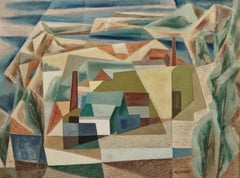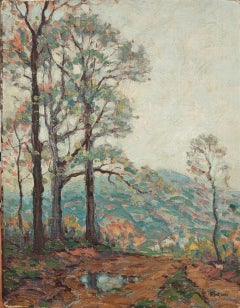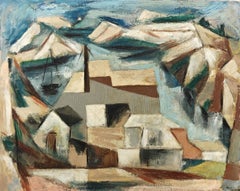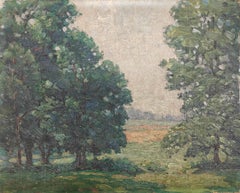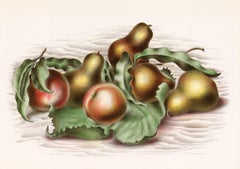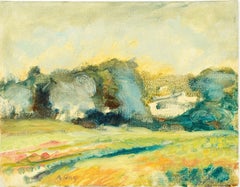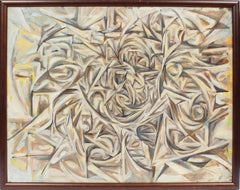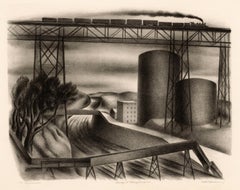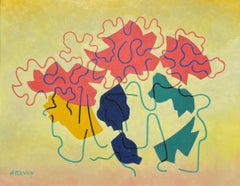Albert Heckman Art
American, 1893-1971
Born in Meadville, Pennsylvania, Heckman came to NYC in 1915 and divided his time between there and Woodstock for the rest of his life except for 1929, when he studied in Leipzig. Married to concert violinist Florence Hardeman. Position: teacher, Hunter College, 1930-58; Teachers College Summer School, Woodstock, 1930s. Author: Paintings of Many Lands and Ages. He was a member of the Woodstock Art Association; and was also part of the Works Progress Administration Federal Arts Program in New York City, doing etching and block printing. He was influenced by Cubism and Expressionism.to
1
7
2
2
4
Overall Width
to
Overall Height
to
15
1
9
5
14
1
13
1
5
3
3
2
2
2
2
2
2
1
1
1
1
1
1
1
1
1
14
14
8
8
6
15
10,042
2,761
1,381
1,375
7
7
15
Artist: Albert Heckman
"Cubist Landscape" Albert Heckman, American Modernist, Fractured Landscape
By Albert Heckman
Located in New York, NY
Albert Heckman
Cubist Landscape
Signed lower right
Oil on canvas
21 3/4 x 30 inches
Albert Heckman was born in Meadville, Western Pennsylvania, 1893. He went to New York City to tr...
Category
1940s American Modern Albert Heckman Art
Materials
Canvas, Oil
"Woodstock Landscape" Albert Heckman, American Modernist, Atmospheric Valley
By Albert Heckman
Located in New York, NY
Albert Heckman
Woodstock Landscape
Oil on board
10 x 8 inches
Albert Heckman was born in Meadville, Western Pennsylvania, 1893. He went to New York City to try his hand at the art ...
Category
1940s American Modern Albert Heckman Art
Materials
Oil, Board
"Cubist Landscape" Albert Heckman, American Modernism, Woodstock, Earth Tones
By Albert Heckman
Located in New York, NY
Albert Heckman
Cubist Landscape
Oil on canvas
16 x 20 inches
Albert Heckman was born in Meadville, Western Pennsylvania, 1893. He went to New York City to try his hand at the art w...
Category
1940s American Modern Albert Heckman Art
Materials
Canvas, Oil
"Woodstock Landscape" Albert Heckman, Modernist, Rich Green Vegetation, WPA
By Albert Heckman
Located in New York, NY
Albert Heckman
Woodstock Landscape
Oil on board
8 x 10 inches
Albert Heckman was born in Meadville, Western Pennsylvania, 1893. He went to New York City to try his hand at the art ...
Category
1940s American Modern Albert Heckman Art
Materials
Oil, Board
'Fruit Forms' — American Modernism
By Albert Heckman
Located in Myrtle Beach, SC
Albert Heckman, 'Fruit Forms', color lithograph, edition not stated, c. 1935. Signed and titled in pencil. A fine, richly-inked impression, with fresh colo...
Category
1930s American Modern Albert Heckman Art
Materials
Lithograph
"Untitled" Albert Heckman, Mid-Century American Modernist Abstract Composition
By Albert Heckman
Located in New York, NY
Albert Heckman
Untitled
Signed lower left
Oil on canvas
20 x 24 inches
Albert Heckman was born in Meadville, Western Pennsylvania, 1893. He went to New York City to try his hand at...
Category
1950s Modern Albert Heckman Art
Materials
Canvas, Oil
"Untitled" Albert Heckman, Still Life, Floral Abstracted Modernist Composition
By Albert Heckman
Located in New York, NY
Albert Heckman
Untitled, circa 1950
Signed lower right
Oil on canvas
25 1/4 x 32 1/4 inches
Albert Heckman was born in Meadville, Western Pennsylvania, 1893. He went to New York City to try his hand at the art world in 1915 after graduating from high school and landing a job at the Meadville Post Office. In 1917, at the age of 24, Heckman enrolled part-time in Teachers' College, Columbia University's Fine Arts Department to begin his formal art education. He worked as a freelance ceramic and textile designer and occasionally as a lecturer at the Metropolitan Museum of Art. In the early 1920s, at the age of almost 30, he graduated with a Bachelor of Arts degree from Columbia Teachers College. He was especially impacted by his instructor at Columbia, Arthur Wesley Dow.
After graduating, he was hired by the Teachers' College as a Fine Arts instructor. He stayed with Columbia Teachers' College until 1929, when he left to attend the Leipzig Institute of Graphic Arts in Leipzig, Germany. Isami Doi (1903-1965), who was born in Hawaii, was arguably his most impressive student at Columbia. Doi is now regarded as one of the most prominent artists hailing from Hawaii. Heckman became an active member and officer of the Keramic Society and Design Guild of New York in the 1920s as part of his early commercial art career. The Society's mission was to share knowledge and showcase textile and ceramic design exhibits.
In 1922, Heckman married Florence Hardman, a concert violinist. Mrs. Heckman's concert schedule during the 1920s kept Albert and Florence Heckman apart for a significant portion of the time, but they spent what little time they had together designing and building their Woodstock, New York, summer house and grounds. A small house and an acre of surrounding land on Overlook Mountain, just behind the village of Woodstock, were purchased by Albert and Florence Heckman at the time of their marriage. Their Woodstock home, with its connections, friendships, and memories, became a central part of their lives over the years, even though they had an apartment in New York City.
Heckman's main artistic focus shifted to the house on Overlook Mountain and the nearby towns and villages, Kingston, Eddyville, and Glasco. After returning from the Leipzig Institute of Graphic Arts in 1930, Mr. Heckman joined Hunter College as an assistant professor of art. He worked there for almost thirty years, retiring in 1956. Throughout his tenure at Hunter, Mr. Heckman and his spouse spent the summers at their Woodstock residence and the winters in New York City. They were regular and well-known guests at the opera and art galleries in New York. Following his retirement in 1956, the Heckmans settled in Woodstock permanently, with occasional trips to Florida or Europe during the fall and winter. Mr. Heckman's close friends and artistic career were always connected to Woodstock or New York City. He joined the Woodstock art group early on and was greatly influenced by artists like Paul and Caroline Rohland, Emil Ganso, Yasuo Kuniyoshi, Andre Ruellan, and her husband, Jack Taylor.
Heckman operated a summer art school in Woodstock for several years in the 1930s with support from Columbia University, where these and other Woodstock artists gave guest lectures. The Potter's Shop in New York City hosted Mr. Heckman's first art show in December 1928. The exhibit received some positive reviews from critics. The American Institute of Graphic Arts chose the plate of "Wehlen, Saxony" as one of the "Fifty Prints of the Year in 1929." There were sixteen etchings displayed. The remaining plates depicted scenes in Saxony, Germany, while five of the plates were based on scenes in Rondout, New York.
Heckman started switching from etching to black and white lithography by the early 1930s. A lifelong admirer of Heckman's artwork, Mr. Gustave von Groschwitz organized a significant exhibition of Heckman etchings and lithographs at the Ferargil Gallery in New York City in 1933. The exhibition traveled to the Stendahl Galleries in Los Angeles (May 1933), the Charles Lessler Gallery in Philadelphia (May 1933), J.L. Hudson in Detroit (June 1933), and Gumps in San Francisco (July 1933). Together with his early etchings, the exhibition featured brand-new black and white lithographs depicting scenes in and around Woodstock as well as "A View from Tudor City...
Category
1950s Abstract Albert Heckman Art
Materials
Canvas, Oil
"Woodstock Landscape" Albert Heckman, Modernist, Bright Landscape
By Albert Heckman
Located in New York, NY
Albert Heckman
Woodstock Landscape
Oil on board
8 1/2 x 10 1/2 inches
Albert Heckman was born in Meadville, Western Pennsylvania, 1893. He went to New York City to try his hand at ...
Category
1940s American Modern Albert Heckman Art
Materials
Oil, Board
"Untitled" Albert Heckman, Modernist Saturated Blue and Yellow Still Life
By Albert Heckman
Located in New York, NY
Albert Heckman
Untitled, circa 1950
Signed lower right
Oil on canvas
18 x 24 inches
Albert Heckman was born in Meadville, Western Pennsylvania, 1893. He went to New York City to try his hand at the art world in 1915 after graduating from high school and landing a job at the Meadville Post Office. In 1917, at the age of 24, Heckman enrolled part-time in Teachers' College, Columbia University's Fine Arts Department to begin his formal art education. He worked as a freelance ceramic and textile designer and occasionally as a lecturer at the Metropolitan Museum of Art. In the early 1920s, at the age of almost 30, he graduated with a Bachelor of Arts degree from Columbia Teachers College. He was especially impacted by his instructor at Columbia, Arthur Wesley Dow.
After graduating, he was hired by the Teachers' College as a Fine Arts instructor. He stayed with Columbia Teachers' College until 1929, when he left to attend the Leipzig Institute of Graphic Arts in Leipzig, Germany. Isami Doi (1903-1965), who was born in Hawaii, was arguably his most impressive student at Columbia. Doi is now regarded as one of the most prominent artists hailing from Hawaii. Heckman became an active member and officer of the Keramic Society and Design Guild of New York in the 1920s as part of his early commercial art career. The Society's mission was to share knowledge and showcase textile and ceramic design exhibits.
In 1922, Heckman married Florence Hardman, a concert violinist. Mrs. Heckman's concert schedule during the 1920s kept Albert and Florence Heckman apart for a significant portion of the time, but they spent what little time they had together designing and building their Woodstock, New York, summer house and grounds. A small house and an acre of surrounding land on Overlook Mountain, just behind the village of Woodstock, were purchased by Albert and Florence Heckman at the time of their marriage. Their Woodstock home, with its connections, friendships, and memories, became a central part of their lives over the years, even though they had an apartment in New York City.
Heckman's main artistic focus shifted to the house on Overlook Mountain and the nearby towns and villages, Kingston, Eddyville, and Glasco. After returning from the Leipzig Institute of Graphic Arts in 1930, Mr. Heckman joined Hunter College as an assistant professor of art. He worked there for almost thirty years, retiring in 1956. Throughout his tenure at Hunter, Mr. Heckman and his spouse spent the summers at their Woodstock residence and the winters in New York City. They were regular and well-known guests at the opera and art galleries in New York. Following his retirement in 1956, the Heckmans settled in Woodstock permanently, with occasional trips to Florida or Europe during the fall and winter. Mr. Heckman's close friends and artistic career were always connected to Woodstock or New York City. He joined the Woodstock art group early on and was greatly influenced by artists like Paul and Caroline Rohland, Emil Ganso, Yasuo Kuniyoshi, Andre Ruellan, and her husband, Jack...
Category
1950s Modern Albert Heckman Art
Materials
Canvas, Oil
"Woodstock Landscape" Albert Heckman, WPA, Modernist, Farm, Barn, Rural Scene
By Albert Heckman
Located in New York, NY
Albert Heckman
Woodstock Landscape
Oil on board
12 x 16 inches
Albert Heckman was born in Meadville, Western Pennsylvania, 1893. He went to New York City to try his hand at the art...
Category
1940s American Modern Albert Heckman Art
Materials
Oil, Board
"Woodstock Landscape" Albert Heckman, American Modernist Bright Landscape
By Albert Heckman
Located in New York, NY
Albert Heckman
Woodstock Landscape
Oil on board
12 x 16 inches
Albert Heckman was born in Meadville, Western Pennsylvania, 1893. He went to New York City to try his hand at the art...
Category
1940s American Modern Albert Heckman Art
Materials
Oil, Board
"Cluster of Houses near Woodstock" Albert Heckman, American Modernist Landscape
By Albert Heckman
Located in New York, NY
Albert Heckman
Cluster of Houses near Woodstock
Signed lower right
Oil on canvas
10 x 14 inches
Albert Heckman was born in Meadville, Western Pennsylvania, 1893. He went to New Yor...
Category
1940s American Modern Albert Heckman Art
Materials
Canvas, Oil
"Untitled" Albert Heckman, circa 1950 Modernist Colorful Still Life With Fruit
By Albert Heckman
Located in New York, NY
Albert Heckman
Untitled, circa 1950
Signed lower right
Oil on canvas
24 x 30 inches
Albert Heckman was born in Meadville, Western Pennsylvania, 1893. He went to New York City to try his hand at the art world in 1915 after graduating from high school and landing a job at the Meadville Post Office. In 1917, at the age of 24, Heckman enrolled part-time in Teachers' College, Columbia University's Fine Arts Department to begin his formal art education. He worked as a freelance ceramic and textile designer and occasionally as a lecturer at the Metropolitan Museum of Art. In the early 1920s, at the age of almost 30, he graduated with a Bachelor of Arts degree from Columbia Teachers College. He was especially impacted by his instructor at Columbia, Arthur Wesley Dow.
After graduating, he was hired by the Teachers' College as a Fine Arts instructor. He stayed with Columbia Teachers' College until 1929, when he left to attend the Leipzig Institute of Graphic Arts in Leipzig, Germany. Isami Doi (1903-1965), who was born in Hawaii, was arguably his most impressive student at Columbia. Doi is now regarded as one of the most prominent artists hailing from Hawaii. Heckman became an active member and officer of the Keramic Society and Design Guild of New York in the 1920s as part of his early commercial art career. The Society's mission was to share knowledge and showcase textile and ceramic design exhibits.
In 1922, Heckman married Florence Hardman, a concert violinist. Mrs. Heckman's concert schedule during the 1920s kept Albert and Florence Heckman apart for a significant portion of the time, but they spent what little time they had together designing and building their Woodstock, New York, summer house and grounds. A small house and an acre of surrounding land on Overlook Mountain, just behind the village of Woodstock, were purchased by Albert and Florence Heckman at the time of their marriage. Their Woodstock home, with its connections, friendships, and memories, became a central part of their lives over the years, even though they had an apartment in New York City.
Heckman's main artistic focus shifted to the house on Overlook Mountain and the nearby towns and villages, Kingston, Eddyville, and Glasco. After returning from the Leipzig Institute of Graphic Arts in 1930, Mr. Heckman joined Hunter College as an assistant professor of art. He worked there for almost thirty years, retiring in 1956. Throughout his tenure at Hunter, Mr. Heckman and his spouse spent the summers at their Woodstock residence and the winters in New York City. They were regular and well-known guests at the opera and art galleries in New York. Following his retirement in 1956, the Heckmans settled in Woodstock permanently, with occasional trips to Florida or Europe during the fall and winter. Mr. Heckman's close friends and artistic career were always connected to Woodstock or New York City. He joined the Woodstock art group early on and was greatly influenced by artists like Paul and Caroline Rohland, Emil Ganso, Yasuo Kuniyoshi, Andre Ruellan, and her husband, Jack...
Category
1950s Modern Albert Heckman Art
Materials
Canvas, Oil
"Woodstock Landscape" Albert Heckman, WPA, American Modernist, New York
By Albert Heckman
Located in New York, NY
Albert Heckman
Woodstock Landscape
Oil on board
12 x 16 inches
Albert Heckman was born in Meadville, Western Pennsylvania, 1893. He went to New York City to try his hand at the art...
Category
1940s American Modern Albert Heckman Art
Materials
Oil, Board
"Untitled" Albert Heckman, 1950s Modernist Abstracted Still Life Painting
By Albert Heckman
Located in New York, NY
Albert Heckman
Untitled, circa 1950
Signed lower right
Oil on canvas
21 1/4 x 29 inches
Albert Heckman was born in Meadville, Western Pennsylvania, 1893. He went to New York City to try his hand at the art world in 1915 after graduating from high school and landing a job at the Meadville Post Office. In 1917, at the age of 24, Heckman enrolled part-time in Teachers' College, Columbia University's Fine Arts Department to begin his formal art education. He worked as a freelance ceramic and textile designer and occasionally as a lecturer at the Metropolitan Museum of Art. In the early 1920s, at the age of almost 30, he graduated with a Bachelor of Arts degree from Columbia Teachers College. He was especially impacted by his instructor at Columbia, Arthur Wesley Dow.
After graduating, he was hired by the Teachers' College as a Fine Arts instructor. He stayed with Columbia Teachers' College until 1929, when he left to attend the Leipzig Institute of Graphic Arts in Leipzig, Germany. Isami Doi (1903-1965), who was born in Hawaii, was arguably his most impressive student at Columbia. Doi is now regarded as one of the most prominent artists hailing from Hawaii. Heckman became an active member and officer of the Keramic Society and Design Guild of New York in the 1920s as part of his early commercial art career. The Society's mission was to share knowledge and showcase textile and ceramic design exhibits.
In 1922, Heckman married Florence Hardman, a concert violinist. Mrs. Heckman's concert schedule during the 1920s kept Albert and Florence Heckman apart for a significant portion of the time, but they spent what little time they had together designing and building their Woodstock, New York, summer house and grounds. A small house and an acre of surrounding land on Overlook Mountain, just behind the village of Woodstock, were purchased by Albert and Florence Heckman at the time of their marriage. Their Woodstock home, with its connections, friendships, and memories, became a central part of their lives over the years, even though they had an apartment in New York City.
Heckman's main artistic focus shifted to the house on Overlook Mountain and the nearby towns and villages, Kingston, Eddyville, and Glasco. After returning from the Leipzig Institute of Graphic Arts in 1930, Mr. Heckman joined Hunter College as an assistant professor of art. He worked there for almost thirty years, retiring in 1956. Throughout his tenure at Hunter, Mr. Heckman and his spouse spent the summers at their Woodstock residence and the winters in New York City. They were regular and well-known guests at the opera and art galleries in New York. Following his retirement in 1956, the Heckmans settled in Woodstock permanently, with occasional trips to Florida or Europe during the fall and winter. Mr. Heckman's close friends and artistic career were always connected to Woodstock or New York City. He joined the Woodstock art group early on and was greatly influenced by artists like Paul and Caroline Rohland, Emil Ganso, Yasuo Kuniyoshi, Andre Ruellan, and her husband, Jack Taylor.
Heckman operated a summer art school in Woodstock for several years in the 1930s with support from Columbia University, where these and other Woodstock artists gave guest lectures. The Potter's Shop in New York City hosted Mr. Heckman's first art show in December 1928. The exhibit received some positive reviews from critics. The American Institute of Graphic Arts chose the plate of "Wehlen, Saxony" as one of the "Fifty Prints of the Year in 1929." There were sixteen etchings displayed. The remaining plates depicted scenes in Saxony, Germany, while five of the plates were based on scenes in Rondout, New York.
Heckman started switching from etching to black and white lithography by the early 1930s. A lifelong admirer of Heckman's artwork, Mr. Gustave von Groschwitz organized a significant exhibition of Heckman etchings and lithographs at the Ferargil Gallery in New York City in 1933. The exhibition traveled to the Stendahl Galleries in Los Angeles (May 1933), the Charles Lessler Gallery in Philadelphia (May 1933), J.L. Hudson in Detroit (June 1933), and Gumps in San Francisco (July 1933). Together with his early etchings, the exhibition featured brand-new black and white lithographs depicting scenes in and around Woodstock as well as "A View from Tudor City...
Category
1950s American Modern Albert Heckman Art
Materials
Canvas, Oil
Related Items
Virginia Hills American Female Modernist Abstract Signed Landscape Oil Painting
Located in Buffalo, NY
Antique American modernist abstract signed oil painting by Anne Sharp. Oil on canvas. Signed.
Category
1970s Modern Albert Heckman Art
Materials
Canvas, Oil
$396 Sale Price
20% Off
H 9 in W 12 in D 2 in
Antique American Modernist Abstract Expressionist Original Florida Oil Painting
Located in Buffalo, NY
Antique American modernist abstract oil painting. Oil on canvas, circa 1960. No signature found. Displayed in a period frame. Image, 30"...
Category
1960s Modern Albert Heckman Art
Materials
Canvas, Oil
$1,036 Sale Price
20% Off
H 24 in W 30 in D 2 in
1940s Mexican City Scene by Famed Artist Francis Chapin, San Miguel de Allende
By Francis Chapin
Located in Chicago, IL
A charming, vibrant, early Mexican city street scene by famed Chicago Modern artist Francis Chapin (Am. 1899-1965). Depicting a bustling, picturesque view of the shaded, arched arcade of the Portal de Guadalupe in the historic city of San Miguel de Allende, the painting is oil on canvas and dates circa 1940. The towering pink spire of the majestic church, the Parroquia de San Miguel Arcángel...
Category
1940s American Modern Albert Heckman Art
Materials
Oil, Canvas
$1,200
H 21 in W 26 in D 2 in
Vintage Abstracted Cape Cod Landscape Original Modernist Pastel Painting
Located in Buffalo, NY
Antique American modernist landscape pastel painting. Pastel on board. Framed in plexi box.
Category
1950s Modern Albert Heckman Art
Materials
Canvas, Oil
$596 Sale Price
25% Off
H 24 in W 30 in D 2 in
Frederick Shane “Twilight of History” 1947 Surrealist Oil Painting, Signed
By Frederick Shane
Located in Denver, CO
"Twilight of History" is a powerful and evocative original oil painting on board by renowned American artist Frederick Shane (1906–1992), created in 1947. This deeply symbolic work e...
Category
1940s American Modern Albert Heckman Art
Materials
Oil, Board
$3,750
H 24.5 in W 28.5 in D 2.75 in
Till the Clouds Roll By 1945 Frank Sinatra Mid Century Modern Hollywood Film WPA
By Richard Whorf
Located in New York, NY
Till the Clouds Roll By 1945 Frank Sinatra Mid Century Modern Hollywood Film WPA
TILL THE COULDS ROLL BY (Film Set), oil on canvas, 20 x 24 inches signed “Richard Whorf” lower right and signed and dated on the verso “R. Whorf/ Dec. 21, 1945. Frame by Hendenryk.
ABOUT THE PAINTING
This painting is from the collection of Barbara and Frank Sinatra, dated December 21, 1945 (just nine days after Frank Sinatra’s 30th birthday), and depicts the Metro-Goldwyn-Mayer Culver City backlot during the filming of Till the Clouds Roll By, the direction of the film having been taking over by Richard Whorf in December 1945. It is not presently clear if Whorf gave the Sinatras this painting as a gift, as the presence of the Dalzell Hatfield Galleries label on the verso indicates the painting may have been sourced there. Frank and Nancy Sinatra acquired a number of works from Dalzell Hatfield Galleries during the 1940’s, or perhaps they framed it for the couple.
Sinatra performed “Old Man River’ in the film. Sinatra and June Allyson are depicted in the center of the painting.
PROVENANCE From the Estate of Mrs. Nancy Sinatra; Dalzell Hatfield Galleries, Ambassador Hotel, Los Angeles.
An image of the Dalzell Hatfield label and the back of the original frame (which we replaced with a stunning Heydenrk frame) are attached.
Nancy Sinatra was Fran's first wife. Nancy Rose Barbato was 17 years old when she met Frank Sinatra, an 18-year-old singer from Hoboken, on the Jersey Shore in the summer of 1934. They married in 1939 at Our Lady of Sorrows Church in Jersey City where Frank gave Nancy a recording of a song dedicated to her titled "Our Love" as a wedding present. The young newlyweds lived and worked in New Jersey, where Frank worked as an unknown singing waiter and master of ceremonies at the Rustic Cabin while Nancy worked as a secretary at the American Type Founders.
His musical career took off after singing with big band leaders Harry James and Tommy Dorsey...
Category
1940s American Modern Albert Heckman Art
Materials
Canvas, Oil
$75,000
H 31 in W 27 in D 2 in
A Large, Dynamic Mid-Century Modern Figurative Landscape Painting by Rudolph Pen
Located in Chicago, IL
A large, dynamic Mid-Century Modern summer landscape painting with standing female bathers by noted Chicago artist, Rudolph Pen. A wonderful example of the artist's uniquely express...
Category
Mid-20th Century American Modern Albert Heckman Art
Materials
Canvas, Oil
$2,800
H 36 in W 50 in D 2 in
A Colorful, 1950s Mid-Century Modern Pool Hall Scene by Francis Chapin
By Francis Chapin
Located in Chicago, IL
A Vibrant, Colorful, 1950s Mid-Century Modern Pool Hall Scene by Notable Chicago Artist, Francis Chapin. Artwork size: 6 3/4" x 8 1/2", Oil on Masonite, Framed size: 11" x 12 1/2"....
Category
Mid-20th Century American Modern Albert Heckman Art
Materials
Masonite, Oil
$950
H 11 in W 12.5 in D 1 in
Cityscape Mid-20th Century Modern Social Realism American Scene Regionalism WPA
Located in New York, NY
Cityscape Mid-20th Century Modern Social Realism American Scene Regionalism WPA
Samuel Thal (1903 to 1964)
"Cityscene"
12 x 16 inches
Oil on board, c. 1940s
Signed verso
Framed: 19...
Category
1940s American Modern Albert Heckman Art
Materials
Oil, Board
Coney Island, Fourth of July
Located in Los Angeles, CA
Coney Island, Fourth of July, c. 1940s, oil on canvas applied to Masonite, signed upper right, 26 x 21 1/2 inches, presented in its original frame
During the 1930s and 40s, Coney I...
Category
1940s American Modern Albert Heckman Art
Materials
Canvas, Oil, Board
American West Mountainscape by Gunnar Anderson
Located in New York, NY
Gunnar Donald Anderson (American, 1927-2022)
Untitled, c. 20th Century
Oil on board
Sight: 11 1/2 x 15 3/4 in.
Framed: 20 1/2 x 24 1/2 x 1 1/4 i...
Category
20th Century American Modern Albert Heckman Art
Materials
Oil, Board
$2,300
H 20.5 in W 24.5 in D 1.25 in
A Charming 1950s Painting of Lisbon, Portugal by Famed Artist Francis Chapin
By Francis Chapin
Located in Chicago, IL
A Charming, 1950s Painting of Lisbon, Portugal by Famed Chicago Modern Artist Francis Chapin (Am. 1899-1965). Depicting a bustling, colorful view of Lisbon's historic Black Horse Sq...
Category
Mid-20th Century American Modern Albert Heckman Art
Materials
Canvas, Oil, Board
$1,200
H 11.25 in W 13.25 in D 1.25 in
Previously Available Items
'Bridge at Poughkeepsie' — WPA Era American Modernism
By Albert Heckman
Located in Myrtle Beach, SC
Albert Heckman (1893-1971), 'Bridge at Poughkeepsie', lithograph, 1934, edition 30. Signed, titled, and annotated '30 Impressions' in pencil. A superb, richly-inked impression, on cr...
Category
1930s American Modern Albert Heckman Art
Materials
Lithograph
H 12.63 in W 16.38 in D 0.01 in
"Untitled" Albert Heckman, Floral Modernist Saturated Abstracted Still Life
By Albert Heckman
Located in New York, NY
Albert Heckman
Untitled, circa 1950
Signed lower left
Oil on canvas
25 x 32 inches
Albert Heckman was born in Meadville, Western Pennsylvania, 1893. He went to New York City to try his hand at the art world in 1915 after graduating from high school and landing a job at the Meadville Post Office. In 1917, at the age of 24, Heckman enrolled part-time in Teachers' College, Columbia University's Fine Arts Department to begin his formal art education. He worked as a freelance ceramic and textile designer and occasionally as a lecturer at the Metropolitan Museum of Art. In the early 1920s, at the age of almost 30, he graduated with a Bachelor of Arts degree from Columbia Teachers College. He was especially impacted by his instructor at Columbia, Arthur Wesley Dow.
After graduating, he was hired by the Teachers' College as a Fine Arts instructor. He stayed with Columbia Teachers' College until 1929, when he left to attend the Leipzig Institute of Graphic Arts in Leipzig, Germany. Isami Doi (1903-1965), who was born in Hawaii, was arguably his most impressive student at Columbia. Doi is now regarded as one of the most prominent artists hailing from Hawaii. Heckman became an active member and officer of the Keramic Society and Design Guild of New York in the 1920s as part of his early commercial art career. The Society's mission was to share knowledge and showcase textile and ceramic design exhibits.
In 1922, Heckman married Florence Hardman, a concert violinist. Mrs. Heckman's concert schedule during the 1920s kept Albert and Florence Heckman apart for a significant portion of the time, but they spent what little time they had together designing and building their Woodstock, New York, summer house and grounds. A small house and an acre of surrounding land on Overlook Mountain, just behind the village of Woodstock, were purchased by Albert and Florence Heckman at the time of their marriage. Their Woodstock home, with its connections, friendships, and memories, became a central part of their lives over the years, even though they had an apartment in New York City.
Heckman's main artistic focus shifted to the house on Overlook Mountain and the nearby towns and villages, Kingston, Eddyville, and Glasco. After returning from the Leipzig Institute of Graphic Arts in 1930, Mr. Heckman joined Hunter College as an assistant professor of art. He worked there for almost thirty years, retiring in 1956. Throughout his tenure at Hunter, Mr. Heckman and his spouse spent the summers at their Woodstock residence and the winters in New York City. They were regular and well-known guests at the opera and art galleries in New York. Following his retirement in 1956, the Heckmans settled in Woodstock permanently, with occasional trips to Florida or Europe during the fall and winter. Mr. Heckman's close friends and artistic career were always connected to Woodstock or New York City. He joined the Woodstock art group early on and was greatly influenced by artists like Paul and Caroline Rohland, Emil Ganso, Yasuo Kuniyoshi, Andre Ruellan, and her husband, Jack Taylor.
Heckman operated a summer art school in Woodstock for several years in the 1930s with support from Columbia University, where these and other Woodstock artists gave guest lectures. The Potter's Shop in New York City hosted Mr. Heckman's first art show in December 1928. The exhibit received some positive reviews from critics. The American Institute of Graphic Arts chose the plate of "Wehlen, Saxony" as one of the "Fifty Prints of the Year in 1929." There were sixteen etchings displayed. The remaining plates depicted scenes in Saxony, Germany, while five of the plates were based on scenes in Rondout, New York.
Heckman started switching from etching to black and white lithography by the early 1930s. A lifelong admirer of Heckman's artwork, Mr. Gustave von Groschwitz organized a significant exhibition of Heckman etchings and lithographs at the Ferargil Gallery in New York City in 1933. The exhibition traveled to the Stendahl Galleries in Los Angeles (May 1933), the Charles Lessler Gallery in Philadelphia (May 1933), J.L. Hudson in Detroit (June 1933), and Gumps in San Francisco (July 1933). Together with his early etchings, the exhibition featured brand-new black and white lithographs depicting scenes in and around Woodstock as well as "A View from Tudor City...
Category
1950s Abstract Albert Heckman Art
Materials
Canvas, Oil
"Untitled" Albert Heckman, 1950s Modernist Abstracted Still Life Composition
By Albert Heckman
Located in New York, NY
Albert Heckman
Untitled, circa 1950
Signed lower right
Oil on canvas
25 x 32 inches
Albert Heckman was born in Meadville, Western Pennsylvania, 1893. He went to New York City to try his hand at the art world in 1915 after graduating from high school and landing a job at the Meadville Post Office. In 1917, at the age of 24, Heckman enrolled part-time in Teachers' College, Columbia University's Fine Arts Department to begin his formal art education. He worked as a freelance ceramic and textile designer and occasionally as a lecturer at the Metropolitan Museum of Art. In the early 1920s, at the age of almost 30, he graduated with a Bachelor of Arts degree from Columbia Teachers College. He was especially impacted by his instructor at Columbia, Arthur Wesley Dow.
After graduating, he was hired by the Teachers' College as a Fine Arts instructor. He stayed with Columbia Teachers' College until 1929, when he left to attend the Leipzig Institute of Graphic Arts in Leipzig, Germany. Isami Doi (1903-1965), who was born in Hawaii, was arguably his most impressive student at Columbia. Doi is now regarded as one of the most prominent artists hailing from Hawaii. Heckman became an active member and officer of the Keramic Society and Design Guild of New York in the 1920s as part of his early commercial art career. The Society's mission was to share knowledge and showcase textile and ceramic design exhibits.
In 1922, Heckman married Florence Hardman, a concert violinist. Mrs. Heckman's concert schedule during the 1920s kept Albert and Florence Heckman apart for a significant portion of the time, but they spent what little time they had together designing and building their Woodstock, New York, summer house and grounds. A small house and an acre of surrounding land on Overlook Mountain, just behind the village of Woodstock, were purchased by Albert and Florence Heckman at the time of their marriage. Their Woodstock home, with its connections, friendships, and memories, became a central part of their lives over the years, even though they had an apartment in New York City.
Heckman's main artistic focus shifted to the house on Overlook Mountain and the nearby towns and villages, Kingston, Eddyville, and Glasco. After returning from the Leipzig Institute of Graphic Arts in 1930, Mr. Heckman joined Hunter College as an assistant professor of art. He worked there for almost thirty years, retiring in 1956. Throughout his tenure at Hunter, Mr. Heckman and his spouse spent the summers at their Woodstock residence and the winters in New York City. They were regular and well-known guests at the opera and art galleries in New York. Following his retirement in 1956, the Heckmans settled in Woodstock permanently, with occasional trips to Florida or Europe during the fall and winter. Mr. Heckman's close friends and artistic career were always connected to Woodstock or New York City. He joined the Woodstock art group early on and was greatly influenced by artists like Paul and Caroline Rohland, Emil Ganso, Yasuo Kuniyoshi, Andre Ruellan, and her husband, Jack...
Category
1950s Modern Albert Heckman Art
Materials
Canvas, Oil
"Glasco Landscape" Albert Heckman, circa 1940 New York Modernist Landscape
By Albert Heckman
Located in New York, NY
Albert Heckman
Glasco Landscape, circa 1940
Signed lower right
Oil on canvas
25 1/4 x 39 1/2 inches
Albert Heckman was born in Meadville, Western Pennsylvania, 1893. He went to New York City to try his hand at the art world in 1915 after graduating from high school and landing a job at the Meadville Post Office. In 1917, at the age of 24, Heckman enrolled part-time in Teachers' College, Columbia University's Fine Arts Department to begin his formal art education. He worked as a freelance ceramic and textile designer and occasionally as a lecturer at the Metropolitan Museum of Art. In the early 1920s, at the age of almost 30, he graduated with a Bachelor of Arts degree from Columbia Teachers College. He was especially impacted by his instructor at Columbia, Arthur Wesley Dow.
After graduating, he was hired by the Teachers' College as a Fine Arts instructor. He stayed with Columbia Teachers' College until 1929, when he left to attend the Leipzig Institute of Graphic Arts in Leipzig, Germany. Isami Doi (1903-1965), who was born in Hawaii, was arguably his most impressive student at Columbia. Doi is now regarded as one of the most prominent artists hailing from Hawaii. Heckman became an active member and officer of the Keramic Society and Design Guild of New York in the 1920s as part of his early commercial art career. The Society's mission was to share knowledge and showcase textile and ceramic design exhibits.
In 1922, Heckman married Florence Hardman, a concert violinist. Mrs. Heckman's concert schedule during the 1920s kept Albert and Florence Heckman apart for a significant portion of the time, but they spent what little time they had together designing and building their Woodstock, New York, summer house and grounds. A small house and an acre of surrounding land on Overlook Mountain, just behind the village of Woodstock, were purchased by Albert and Florence Heckman at the time of their marriage. Their Woodstock home, with its connections, friendships, and memories, became a central part of their lives over the years, even though they had an apartment in New York City.
Heckman's main artistic focus shifted to the house on Overlook Mountain and the nearby towns and villages, Kingston, Eddyville, and Glasco. After returning from the Leipzig Institute of Graphic Arts in 1930, Mr. Heckman joined Hunter College as an assistant professor of art. He worked there for almost thirty years, retiring in 1956. Throughout his tenure at Hunter, Mr. Heckman and his spouse spent the summers at their Woodstock residence and the winters in New York City. They were regular and well-known guests at the opera and art galleries in New York. Following his retirement in 1956, the Heckmans settled in Woodstock permanently, with occasional trips to Florida or Europe during the fall and winter. Mr. Heckman's close friends and artistic career were always connected to Woodstock or New York City. He joined the Woodstock art group early on and was greatly influenced by artists like Paul and Caroline Rohland, Emil Ganso, Yasuo Kuniyoshi, Andre Ruellan, and her husband, Jack...
Category
1940s American Modern Albert Heckman Art
Materials
Canvas, Oil
Albert Heckman, Fruit Forms
By Albert Heckman
Located in New York, NY
There's just something about Albert Heckman's drawing technique that is so pleasing to the eye! There's a color version of this still life as well -- very close in composition but wi...
Category
Mid-20th Century American Modern Albert Heckman Art
Materials
Lithograph
Industrial Theme
By Albert Heckman
Located in Myrtle Beach, SC
Albert Heckman (1893-1971), 'Industrial Theme', color lithograph, c. 1940, edition 25. Signed, titled and annotated 'Edition 25' and inscribed 'To Walter Isaacs from Albert Heckman' ...
Category
1940s American Modern Albert Heckman Art
Materials
Lithograph
Clay Banks
By Albert Heckman
Located in Storrs, CT
Lithograph printed in colors. 13 3/4 x 19 13/16 (19 x 23 5/8). Edition 15. Printed on the full sheet of white wove paper, with deckle edges. Signed, titled and annotated in pencil. ...
Category
Mid-20th Century Abstract Albert Heckman Art
Materials
Color, Lithograph
Albert Heckman art for sale on 1stDibs.
Find a wide variety of authentic Albert Heckman art available for sale on 1stDibs. You can also browse by medium to find art by Albert Heckman in lithograph and more. Much of the original work by this artist or collective was created during the 1930s and is mostly associated with the modern style. Not every interior allows for large Albert Heckman art, so small editions measuring 16 inches across are available. Customers who are interested in this artist might also find the work of Carol Wax, Judith Rothchild, and Lynd Ward. Albert Heckman art prices can differ depending upon medium, time period and other attributes. On 1stDibs, the price for these items starts at $850 and tops out at $850, while the average work can sell for $850.
